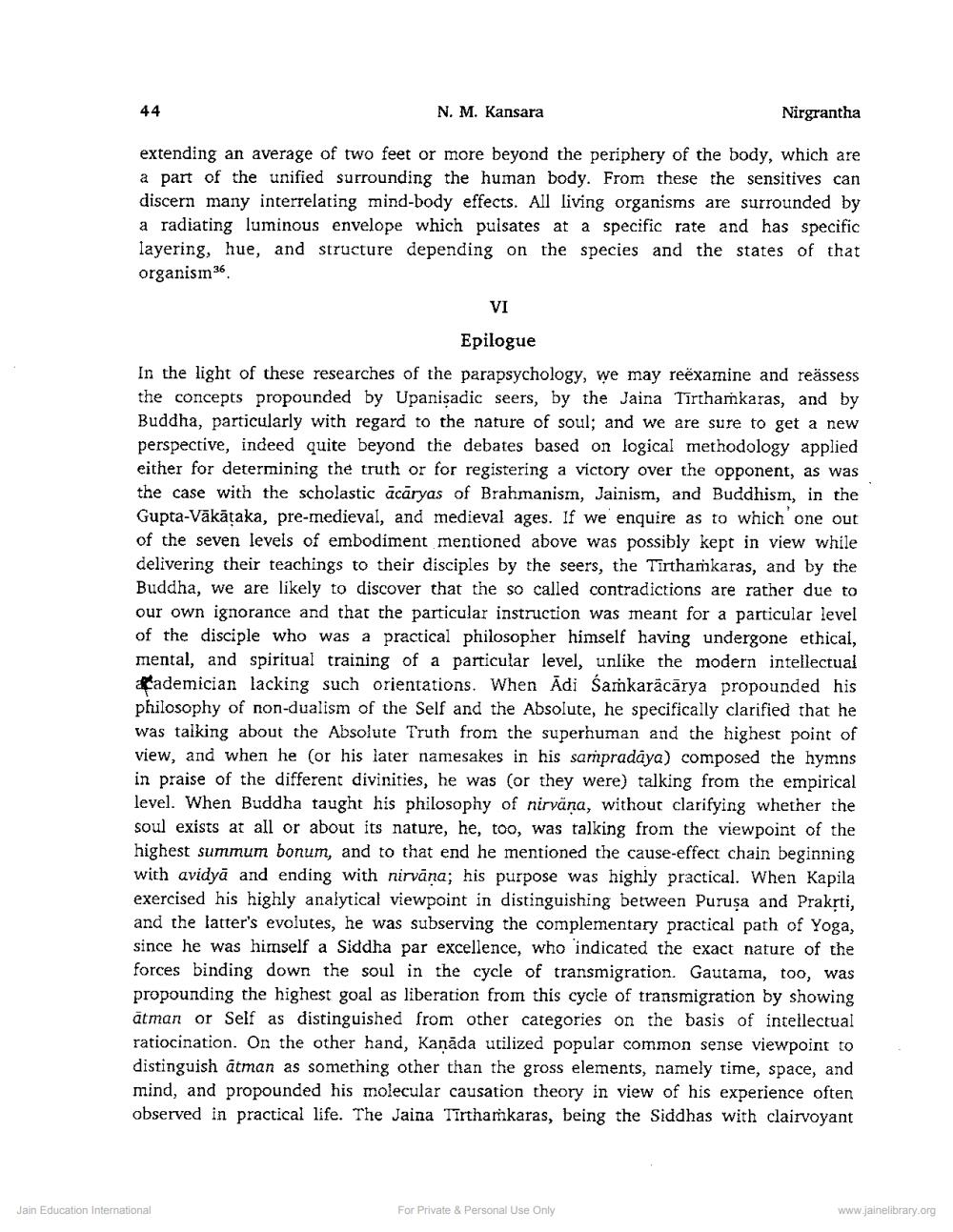Book Title: Nature of Soul in Jainism Parapsychological View Point Author(s): N M Kansara Publisher: Z_Nirgrantha_1_022701.pdf and Nirgrantha_2_022702.pdf and Nirgrantha_3_022703.pdf View full book textPage 8
________________ 44 N. M. Kansara Nirgrantha extending an average of two feet or more beyond the periphery of the body, which are a part of the unified surrounding the human body. From these the sensitives can discern many interrelating mind-body effects. All living organisms are surrounded by a radiating luminous envelope which puisates at a specific rate and has specific layering, hue, and structure depending on the species and the states of that organisin 36 VI Epilogue In the light of these researches of the parapsychology, we may reexamine and reassess the concepts propounded by Upanisadic seers, by the Jaina Tīrthařkaras, and by Buddha, particularly with regard to the nature of soul; and we are sure to get a new perspective, indeed quite beyond the debates based on logical methodology applied either for determining the truth or for registering a victory over the opponent, as was the case with the scholastic acāryas of Brahmanism, Jainism, and Buddhism, in the Gupta-Vākātaka, pre-medieval, and medieval ages. If we enquire as to which one out of the seven levels of embodiment mentioned above was possibly kept in view while delivering their teachings to their disciples by the seers, the Tirthamkaras, and by the Buddha, we are likely to discover that the so called contradictions are rather due to our own ignorance and that the particular instruction was meant for a particular level of the disciple who was a practical philosopher himself having undergone ethical, mental, and spiritual training of a particular level, unlike the modern intellectual ademician lacking such orientations. When Adi Śamkarācārya propounded his philosophy of non-dualism of the Self and the Absolute, he specifically clarified that he was talking about the Absolute Truth from the superhuman and the highest point of view, and when he (or his later namesakes in his sampradāya) composed the hymns in praise of the different divinities, he was (or they were) talking from the empirical level. When Buddha taught his philosophy of nirvana, without clarifying whether the soul exists at all or about its nature, he, too, was talking from the viewpoint of the highest summum bonum, and to that end he mentioned the cause-effect chain beginning with avidyā and ending with nirvana; his purpose was highly practical. When Kapila exercised his highly analytical viewpoint in distinguishing between Purusa and Prakrti, and the latter's evolutes, he was subserving the complementary practical path of Yoga, since he was himself a Siddha par excellence, who indicated the exact nature of the forces binding down the soul in the cycle of transmigration. Gautama, too, was propounding the highest goal as liberation from this cycle of transmigration by showing atman or Self as distinguished from other categories on the basis of intellectual ratiocination. On the other hand, Kanāda utilized popular common sense viewpoint to distinguish atman as something other than the gross elements, namely time, space, and mind, and propounded his molecular causation theory in view of his experience often observed in practical life. The Jaina Tirthamkaras, being the Siddhas with clairvoyant Jain Education International For Private & Personal Use Only www.jainelibrary.orgPage Navigation
1 ... 6 7 8 9 10 11
